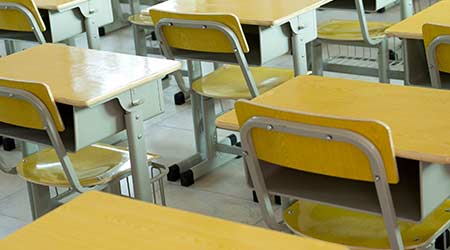How To Manage and Remove PCBs from School Facilities
If PCBs are found on a site, here are the steps FMs should take to remove them so as to reduce the potential for lawsuits.
If identified PCBs are to remain at the site, a management plan should be developed and implemented. Under the management plan, staff at the site must work with the EPA regional PCB coordinator to manage the materials in place. If PCB-impacted materials are to be left in place, the management plan will typically include an ongoing surveillance program, including surface and air sampling. Additionally, building owners are typically required to record a deed restriction indicating the presence of PCBs at the site.
As a best practice, EPA recommends that building owners and facility managers remove PCB-containing caulk, paint, and other materials during planned renovations, as well as removing all PCB fluorescent light ballasts (sudden failure of a light ballast exceeding its lifespan can emit PCBs and cause undue exposure and add significant clean-up costs).
In addition, whether or not PCBs have been identified in school buildings, EPA recommends the following best management practices on a routine basis to minimize potential exposures:
- Ensure ventilation systems are working properly and are routinely inspected.
- Encapsulation by means of a coating material may help reduce air emissions from PCB sources.
- Use wet cloths when cleaning surfaces.
- Never sweep with brooms; instead use vacuums with high efficiency particulate air (HEPA) filters.
- Reduce dust and residue by frequently cleaning inside schools.
- Wash hands with soap and water before eating.
To ensure that PCB materials are properly removed to avoid contaminating surrounding surfaces, trained workers using safe work practices should be used to reduce and contain dust from the removal process. Properly trained maintenance staff or experienced contractors should perform all activities involved in PCB removal, cleanup, and disposal. All contractors should be made aware of the regulatory requirements.
Reducing Potential Lawsuits and Regulatory Enforcement
Schools need to be aware of potential citizen lawsuits under the Toxic Substances Control Act. EPA also has enforcement power and tools that it can use where PCBs are present in materials such as caulking if the PCB content is above regulated levels (50 ppm). If PCBs are discovered to be present, it is important to identify key project leaders responsible for ensuring the proper management and disposal of the materials:
- Determining what testing will be conducted and when
- Public relations plan
- Construction team compliance
- Disposal matters
- Legal coordination
School administrators that are responsible for construction projects (renovation, demolition, modernization) involving PCB materials should understand the regulatory requirements regarding the removal/abatement of those materials. They can also consult with experienced environmental professionals or contact their local EPA office.
Occupants of buildings should be notified of upcoming renovation activities involving PCBs. They should be completely isolated from the work areas where PCB renovation or removal activities will occur to prevent exposure to PCBs. Other measures can be taken such as physically isolating the PCB work areas from other areas of the building by means of physical barriers and negative pressure systems.
When testing confirms that PCBs are present in building materials at regulated levels (building materials can also be assumed to contain PCBs in lieu of sampling), they need to be disposed of in accordance with the PCB regulations in 40 CFR part 761, subpart D. Currently, proper sampling of waste streams is required to properly identify potential hazardous wastes. For a construction project which impacts materials that could potentially contain PCBs, say with lead paint, waste profile samples should be collected.
Having a proper understanding of disposal requirements is an absolute necessity. In general, PCBs are classified as either PCB bulk product waste or PCB remediation waste. PCB bulk product waste is non-liquid waste such as building materials and plastics. (Under EPA’s definition, bulk product waste includes building materials coated or serviced with PCBs like caulking and sealants.) PCB remediation waste is waste that is contaminated with PCBs from spills or releases. This includes items such as soil, rags or debris generated during cleanups, sludge, etc. To further complicate the distinction, sometimes materials such as wood or concrete, into which PCBs have leached, may be considered PCB remediation waste. A hazardous waste specialist should be consulted to discuss packaging, labeling, transportation and disposal requirements.
What FMs Need to Know
There was potentially widespread use of PCBs in schools that were renovated or built between 1950 and 1979. However, school administrators can take well-informed actions to reduce potential exposure to PCBs by: characterizing if there are PCBs present; evaluating the options to address the presence of PCBs including removal, encapsulation, and best management practices; determining the correct disposal method; and coordinating construction team compliance and a public relations plan (to effectively communicate with the school community). By implementing these preventive measures, potentially costly legal issues due to exposure to PCBs (citizen lawsuits), unwarranted remediation, and construction delays can be avoided.
Schools should make sure they are aware of the requirements and that they protect themselves from 1) contractors in relation to change order costs and 2) citizen lawsuits and regulatory enforcement. EPA’s main goal regarding PCBs in schools is to ensure that school districts implement recommended actions to limit exposures. EPA believes that, if school districts implement preventive measures, enforcement may not be the best option to reduce exposure in school buildings. In other words, if schools take appropriate proactive measures to reduce PCB exposure, it is likely EPA will make enforcement a low priority, though they would likely get involved in situations where risks to public health were not being addressed.
David Schack (David.Schack@altaenviron.com), CAC, CDPH-IA, is vice president of building services, and Scott Nunes (Scott.Nunes@altaenviron.com), CAC, CDPH-IA, is a senior consultant/project manager with Alta Environmental.
Related Topics:













